
Back to Sidestreet Bannerworks
January 2001
Larry Herget's 0-6-0T
by Marc Horovitz
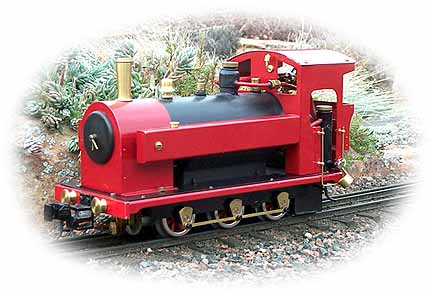
This is the second of Larry Herget's engines to be featured in Loco of the Month (see June, 2000). It is one of a batch of three completed at the end of 1994. As you can see by the pictures, it bears little resemblance to any known prototype and is almost fanciful in nature. I hesitate to describe it as a toy, though, because of the amount of work and engineering that went into it.
When I first received it, I test ran it on Alan Olson's Acoma Central (I was without a railway at the time). It performed nicely for a while, then stopped dead and refused to budge, all the while pouring out great gobs of steam. I dropped the fire and had a good look around the loco but could discover nothing wrong. The wheels still turned smoothly, the cylinder oscillated just fine, and all the plumbing seemed intact. Then a small bit of brass was discovered along the right-of-way. This turned out to be the top cylinder cover. Its absense could not be seen without disassembling the engine, which I then did to confirm the loss. The cylinder cover had indeed departed.
I dropped Larry a note, explaining the situation and asking him if I should do the repair or if he'd rather. He instructed me to remove the cylinder and return it to him, along with the errant cover. This I did and, in due course, the defective cylinder was returned, better than new. Larry also returned the old cover. He had drilled a little hole in it and fastened it to an earring wire. I declined to get my ear pierced to wear it, though.
The engine
The locomotive, despite its funky appearance, is beautifully made. Sheet-metal work is first class. Side tanks are dummies, fastened to the smokebox and cab. The copper boiler is phos-copper brazed, with all bushings silver-soldered in. It is fitted with a safety valve, a filler plug on the steam dome, a drypipe inside the dome, and a Goodall valve for refilling under pressure. A nice amenity is the large water glass in the cab. The usual displacement lubricator is fitted to the footplate. An unusual feature is a fusible plug fitted to the bottom of the boiler, over the wicks.
Power is supplied by a good sized, double-acting oscillating cylinder mounted vertically in the smokebox. This runs a shaft on which is mounted a large steel flywheel and a small helical gear. The gear engages a larger helical crown gear on the first axle. These gears came from Zebco, the fishing-reel company. Gear ratio is 3.5:1
Wheels are reproduction wheels, made by McCoy (no longer in business) as pilot wheels for a Lionel, standard-gauge 400E 4-4-4. The pot-metal flanges were turned to a more scale profile and the steel tires were retained. The locomotive has outside frames, and wheels are coupled with side rods fastened to brass counterweights.
A large alcohol tank resides beneath the cab. This feeds a four-wick burner. A firebox contains the fire and directs it up around the sides of the pot boiler (the side tanks play no part in the fire). Kadee knuckle couplers adorn either end.
Performance
The engine is steamed up in the usual manner. For its Loco of the Month run, I oiled it all around (with a little Lubriplate grease on the gears) and filled the boiler, lubricator, and alcohol tank. The alcohol tank is filled via a tube next to the lubricator. An overflow pipe protrudes from the tank just below the footplate. Once steam was up, in about seven minutes, the throttle was opened. A generous knob in the cab makes control easy. (The engine has no reversing gear.) I pushed it ahead just a little, to clear the condensate, then off it went.
Large, pot-boilered locomotives have a tendency to go and go and go, and this one is no exception. It ran for 50 minutes, with just a quick stop every 15 minutes or so to top up the meths. With the throttle wide open, the engine takes off at an alarming speed, but It is easily controllable and will run quite sedately. I calculated that running at roughly one lap per minute around my 150' loop, the engine traveled nearly a mile and a half (actual)!
| Specifications | |
| Builder | Larry Herget, DeSoto, Missouri |
| Date built | 1994 |
| Gauge | 45mm (gauge 1) |
| Scale | 1:22.5 (sort of) |
| Boiler | Pot boiler |
| Fittings | Safety valve, throttle, water glass, Goodall filler valve, drypipe, fusible plug |
| Fuel | Alcohol |
| Working pressure | 21 psi |
| Cylinders | One, double-acting oscillator inside the smokebox |
| Reversing gear | None |
| Dimensions | Length over buffers, 10-1/4"; width, 4"; height, 5-7/8" |
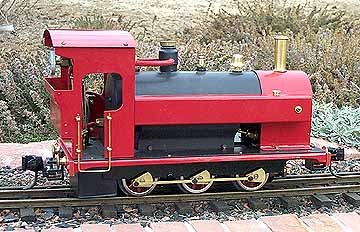
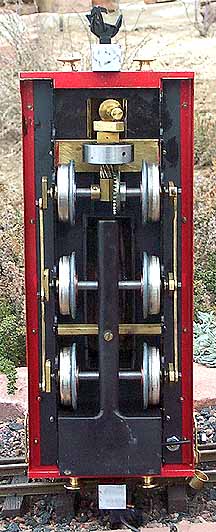
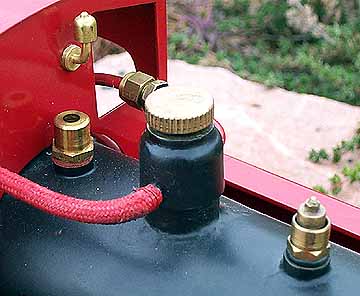
Above: Things atop the boiler include a Goodall filler valve (left), a filler plug on the steam dome, and the safety valve.
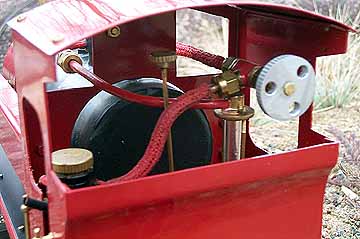
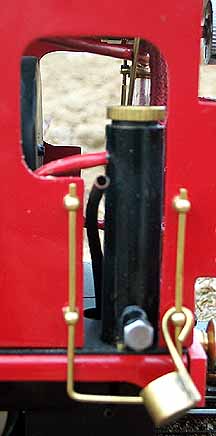
Right: The lubricator conveniently stands in the fireman's door. To the left of it is the filler pipe for the fuel. Hanging from the handrail is a cap that can be used to block one of the burners in warmer weather.
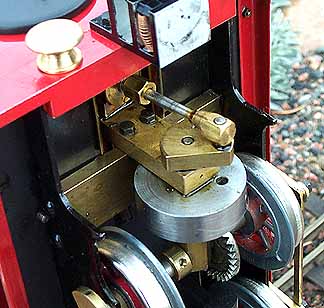
Back to Sidestreet Bannerworks
This page and its contents Copyright Sidestreet Bannerworks, 2001